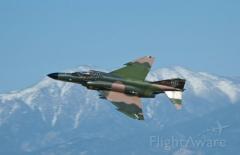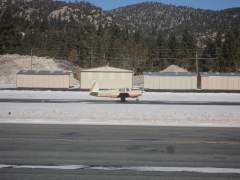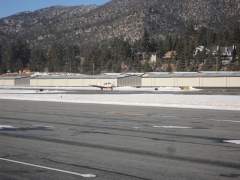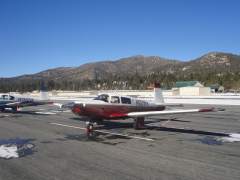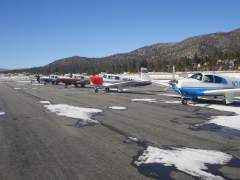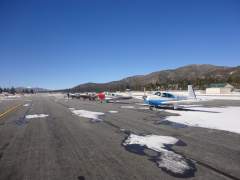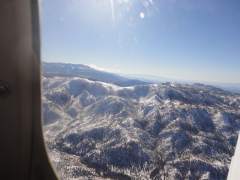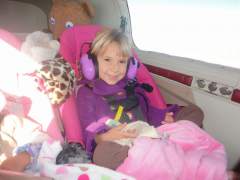-
Posts
495 -
Joined
-
Last visited
-
Days Won
8
Content Type
Profiles
Forums
Blogs
Gallery
Downloads
Events
Store
Everything posted by Dave Marten
-
Great choice...It'll make you a better pilot. Good to invest in the most vital part of your Mooney, YOU! More of us should really spend increasing our pilot skills. Enjoy!
-
201er, For your climb use the Vz profile (previuos thread on LOP climbs-ref testwest's work). WOT/2700 RPM, Target EGT, 115 KIAS until the airplane won't climb 500 fpm, then 500 fpm until speed drops to Vy.
-
L/D max is by definition best guide speed. So yes, use your own aircraft's number and away you go. Lower gross weight slower L/Dmax slower Carson. Ballpark of 120KIAS dependent on GW and model. Yes, if you pull way back to below 55% power then you can look at section 5 again and see you are now not gaining range w/ altitude (no surprise), but look at your 65%+ range charts...altitude matters there. The copy of the J POH I have does not list anything below 55% and 2400 RPM (Jan 96 w/ rev . Can't comment on 2000 RPM cruise range. Carson- "It thus turns out that the best rate of return on excess fuel expended, as measured in additional airspeed will occur when...a 32% increase in airspeed above the optimum will result in only a 16% increase in total fuel used...the flight time will be reduced by 24%....This is clearly the best return in airspeed increase (and hence reduction in flying time) on excess fuel, and as such, must be regarded as the "least wasteful way of wasting,i.e., the most productive use of excess fuel for cruising purposes." 16% more fuel than L/Dmax but 1/4 the less flight time. CAFE KIAS may be higher than carson after taking into account prop efficiency (designed for an optimum rpm range), etc. But, if that means I can complete 25% more flights than somebody flying at L/Dmax. Means I'm completing 4 of the same trips vs 3 and with only a 16% fuel penalty over L/Dmax. I'll defer to those who max CAFE scores, that is a more useful measure of efficiency. Norm wrote his a thesis on it (literally I believe).
-
Gents, reference your speed, power, vs altitude graph in your J model POH Section 5. For a constant % power you can generate more TAS as altitude increases. As you increase alt you squeeze out more speed for a given %HP UNTIL, as the chart depicts, you just can generate the HP (WOT and no more manifold pressure to give). The dreaded "% power not available" line which really cramps your style. Neglecting winds you can work the chart right to left entering with a target speed and %power that you'd like to cruise at and then optimize your altitude based on OAT (at altitude). 201ers intuition that 6-8k is the sweet spot is reflected right there in the chart (depending on OAT). You'll also note that much above 10K it'll be tough to generate power on warmer than standard OAT days. If it is a warm summer day then yes, that lower altitude will get you the speed. Another interesting tidbit for you Carson guys is if Carson (and I'm no carson expert) is about 132 IAS in a J and you're at 8K STD day then you'll about 160 KTAS. Conicidence or design point for the airplane? I like to think the design worked out as intended. Be careful out there and don't hit any palm trees!
-
-
If you know you're landing 24 then you only have two DTW choices. So 50/50. Knowing that the DTW should set you up on a downwind then AVILL makes the best sense, but doesn't hurt to clarify "confirm 24L via AVILL?" I'm no expert in Canadian rules so thanks for the post, good learning exercise. You can always do what we AF guys do when in doubt..request vectors to final!
-
Oh Canada! What you have here is an example both an 'open' and 'closed' STAR. The 'closed' routes terminate directly at the FACF (final approach clearance fix), but the 'open' legs dump you off on the radar downwind for the landing runways (DTW). Approaching HABBS expect the route to the landing runway (your case 24L) so you would have flown HABBS-COMAU-PERNI-AVILL. ATIS (in english) should have called out the approach(es) in use which would have clued you in as to what routing to expect. Some FMS's will not link the 'open' (DTW) fix to the FACF which may require hand jamming, but looks like your system did. Your system correctly sequenced you to SOLKA once you activated the ILS24L. Check out the Canook IFR regs: http://www.tc.gc.ca/eng/civilaviation/publications/tp14371-rac-9-0-2604.htm#rac-9-2 Happy flying up in da nordth, hea!
-
"I wouldn't let approach or tower paint you into a corner- that's when mistakes tend to be made. Diving at the runway at 150 kts and trying to flare off the excess speed is a pretty advanced technique: personally, I would have done just what you did. Go arounds are free- a botched landing can be very expensive" Well said! BL: don't try anything dumb, different, or dangerous when under pressure. If you need to regularly mix it up with the big iron then develop your own technique for keeping the speed up, but practice it so it becomes part of your routine. A technique: If told to maintain best speed, answer back with what you CAN do. That will give ATC a reference so they can tell if they'll have seperation behind you. IE, "Mooney 1RX can give ya 140kts till 1 mile" My own level of agressiveness on approach decreases as pilot workload increases due to factors like night/wx/fatigue/strange field/wet runway/etc.
-
Dmax still had his last time I was there. I had to do a double-take when I first saw it. Ercoupe with a Mooney tail...no kidding. At first I thought DMax had too much time on his hands and built himself a little advertising gimmic!
-
Good news: One of my fellow pilot buddies is now hooked on Mooneys and is looking for a good first airplane! But.....He's got his eye on an M20C for sale at Meadowlake, CO. http://www.meadowlakeairport.com/aircraft_for_sale_co.html It appears she's been on the market about 3 yrs with no change in listed TSMOH or TT (?) I told him he should be wary of a plane that has been sitting that long w/o flying and has been possibly passed-over by buyers for such a long time. Same seller's name attached to listings. Price has come down from $65K in '09 to $49K now. I understand there was a gear-up landing/landing incident resulting in the overhaul. Appreciate any respectful advice or insight on this particular bird you guys may have. Please PM me if you'd rather not share w/ the group. Appears to be a pretty little C model, but I told him to proceed with caution. The May 2009 MAPA log listing below: "1962 M20C Partner or Sale, 7880 hrs TT, 3 hrs SMOH and SPOH, 201 panel and yokes, one piece ¼” tinted windshield, SPA400 4 place intercom and PTT in both yokes, avionics: dual KY197’s, KN53, KNS 80, KT76A, KR87, KMA23, KA44B, back lighted instruments, Sky-Tec starter, M20 air/oil separator, new tires and rubber donuts all around and break hoses, Mitchell wing leveler, Aircraft Components Gear-up alert system, new alternator/regulator, EZ heat (engine), Lasar nose truss, Monroy traffic detector; Electronics Int’l digital volt/amp and EGT/CHT meters, cowl closure, flap gap seals, and wheel well liners, 2000 S/W Jet Glow Bravo paint scheme (white over red/gray stripes), P & I 10, 2 time Oshkosh winner. Hangared at Meadow Lake (OOV) Colorado Springs, CO. $65,000 THANKS!
-

Mooney Fly-in Big Bear
Images added to a gallery album owned by Dave Marten in Old MooneySpace.com Images
-
From the album: Mooney Fly-in Big Bear
-
From the album: Mooney Fly-in Big Bear
-
From the album: Mooney Fly-in Big Bear
-
From the album: Mooney Fly-in Big Bear
-
From the album: Mooney Fly-in Big Bear
-
From the album: Mooney Fly-in Big Bear
-
From the album: Mooney Fly-in Big Bear
-
From the album: Mooney Fly-in Big Bear
-
From the album: Mooney Fly-in Big Bear
-
From the album: Mooney Fly-in Big Bear
-
From the album: Mooney Fly-in Big Bear
-
ICE PILOTS: Big Bear, CA VMG Fly-In (KL35) Saturday, January 12th 2103 The weather could not have been more perfect for a winter Mooney Fly-in! A cold front brought near-record low temperatures to the SoCal region, which was straight out of central casting! Big Bear was blanketed with a couple inches of fresh powder Friday night leaving the Mooney pilots guessing whether or not they would make it in. A call to the airport manager assured that the runway was only covered with patchy snow and the ramp mostly clear. The temperature at Big Bear was 1. Yes, one (singular) degree F! Not to worry the sky was clear with calm winds. In all TEN Mooneys arrived with over twenty people converging on the Barnstorm Café. The fly-in attracted Mooney pilots from Fresno, Las Vegas, Los Angeles, San Diego and all points in between. The temperature has climbed into the double digits by lunch. Renee, proprietor of the Barnstorm café worked magic worthy of a Disney movie as her staff quickly got our rowdy bunch of pilots fed. A trip to Big Bear for just for the food at the Barnstorm Café is well worth it. As predicted the talk revolved around the extreme cold (for a bunch of CA guys). Folks were scrounging through their attics to find enough warm clothes in order to make the flight. The cold snap forced CA pilots to try to pre-heat their aircraft, something which resulted in many clever ideas. The best being the pilot who stole his wife’s hair dryer and sat at the airport for two hours warming the engine. He made it! A good time was had by all, especially the four kids who got to play in the snow for the first (and possibly only) time this season. They kept going till their noses turned red! The fifteen foot high airport snow piles were excellent for sliding down! Big Bear turned out to be an excellent start to our 2013 flying year. The only question on everyone’s mind was, “What’s next?”
-
Happy to help you out. That's what we're here to do! Glad you got your bird away from the nest. dandtmarten@hotmail.com
-
Right on! For the J try the Vz profile!



